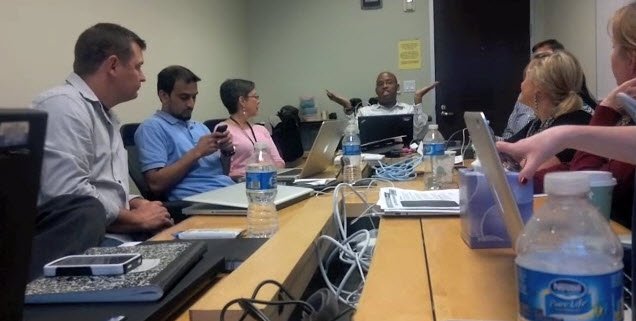8 Lessons For Leading Change
At the beginning of 2012 I resigned as Director of Social & Digital Strategy at RadioShack to embark upon a new challenge with Intuit. As if the task of building an enterprise-wide social practice for one global brand wasn't enough, I was brought to Intuit with an ambitious goal: do it again, faster. But this time around things are different. When I began crafting the blueprint for RadioShack's digital proficiency, I was entering an empty lot. There was no foundation or framework, no sheetrock or shingles - simply potential. Conversely, at Intuit's Accounting Professionals Division I'm more renovator than architect, responsible for casting a vision, enhancing the skills and upgrading efforts. I traded my jackhammer for a paint brush.In just a short time, I've learned numerous insights about effectively leading change for lasting results. Last week I was invited to share these lessons with my fellow Intuit execs and I believe they apply to leaders outside our organization as well.
But this time around things are different. When I began crafting the blueprint for RadioShack's digital proficiency, I was entering an empty lot. There was no foundation or framework, no sheetrock or shingles - simply potential. Conversely, at Intuit's Accounting Professionals Division I'm more renovator than architect, responsible for casting a vision, enhancing the skills and upgrading efforts. I traded my jackhammer for a paint brush.In just a short time, I've learned numerous insights about effectively leading change for lasting results. Last week I was invited to share these lessons with my fellow Intuit execs and I believe they apply to leaders outside our organization as well.
1. Package before distribution
During my first week at Intuit, before I memorized my telephone extension or PC password, I delivered a framework to the entire team that summarized how I would approach change. This package, entitled Project R.U.N., immediately gave everyone a common language and chronology for the months ahead. By packaging the ingredients of change into smaller, traceable containers the team was better able to understand my perspective. Even the heaviest items are easier to hold when you give them handles. (Note: I'll unveil the inner-workings of Project R.U.N. in a later post)
2. Let the team in the lab
From re-orgs and acquisitions to layoffs and promotions, oftentimes organizational change is something that simply happens to us. We waltz into the office one day and everything is different. In some instances it is easier for a leader to administer change much like you would a drug treatment. Lockdown the lab. Concoct the cure. Convince the boss. Inject the drug. Observe the behaviors. But are the side-effects of this approach worth it? In my case, I used surveys, one-on-one meetings, team offsite events and informal conversations to deliberately let the larger team into the lab with me. Sure it takes more time in the beginning but I'm betting on the long-term benefits.
3. Decide how to decide
Unsurprisingly enough, great decisions are the product of good planning. Effectively making decisions requires leaders to carefully consider the proper approach for gathering critical inputs that impact change. Will you consult with select colleagues and then make a decision? Or perhaps you seek 100% consensus among the team? And then there's the good ol' fashion unilateral decision where you pull the trigger all by yourself. No matter your approach, it's important to diagnose your particular business situation and then select the criteria that works for you.
4. Acceptance vs. Agreement
Acceptance is critical, agreement is convenient. Don't confuse them. Acceptance is the oxygen of change, an essential requirement for building shared vision towards an area of enhancement. Acceptance listens to unique and opposing perspectives by going beyond simply respecting an individual's right to an opinion and actually valuing it. Agreement is simply the support of an idea, a convenient nice-to-have but far from a requirement for successful change. On the other hand, acceptance of your team's point-of-view helps translate individual perspectives into collective action.
5. Inspire by doing
Just like Hernan Cortes sunk his fleet of ships when he arrived in the New World to signal to his men that turning back was not an option, leading change means modeling the behaviors you desire among your team. I didn't slash my tires to demonstrate to the Intuit team that I wasn't turning back, but I did attempt to model social and business best practices to build trust and credibility. For instance, when we wanted to incorporate more video content into our customer conversations I began incorporating videos into my team communications. The fear of uncertainty is the biggest enemy to progress, making a leader's actions vitally important to cultivating courage. As a leader, to figure out what actions need modeling ask yourself these 2 questions: What is the #1 thing only I can do? What activity will have the biggest impact on the business if done with excellence? The intersection of those 2 answers is your starting point.
6. Speak honestly and openly
Weaknesses, challenges, gaps, fears and hopes aren't values you'll find in any business case but they are all a natural part of leading human change. While becoming a cyborg would certainly prove beneficial, a robotic approach to change is no replacement for honest conversations. Don't be afraid to share your own story and be transparent about the road ahead. To spark real conversations, start with real inquiries: What would you do if you were me? What are you most concerned about? Given this change, what changes the most for you individually? What big win would you like to contribute to? How can I help you? How can I do better?
7. Know yourself
For me, change in any area of my life has a way of becoming a much-needed mirror into areas of strength and improvement. It's beneficial to identify and own your personal attributes - both good and bad - since they affect your response to change. What triggers you at work? What workplace behaviors do you find totally reprehensible? What actions encourage you? Our team spent a day going through the StrengthsFinder 2.0 book and exercise to discover and share our natural talents. By increasing your emotional and cultural intelligence and awareness of team dynamics, you increase your change IQ.
8. Fear fuels creativity
Margaret Wheatley says it best: “The things we fear most in organizations — fluctuations, disturbances, imbalances — are the primary sources of creativity." Conflicts are opportunities to change, invent and innovate for the better. Remember, feedback is a gift you can only unwrap with your ears.At Intuit, I've learned to embrace change and leverage it as a signature capability. As innovation becomes the norm and disruptive forces shape how we go-to-market, leading change will become synonymous with leading.What lessons has change taught you? Leave a comment below as I'd love to compile this feedback for future blog posts.

